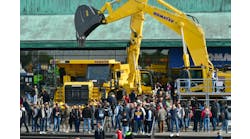With autumn upon us in the northern hemisphere and winter not too far away, here's something to be mindful of with respect to hydraulic tank heaters:
A recent client was carrying out major service work on an industrial hydraulic power unit. While cleaning out the hydraulic tank his technicians discovered lumps of a black, tar-like substance on the bottom of the tank. And I was asked to identify the cause.
The power unit was well maintained, had adequate installed cooling capacity and no history of overheating. This would normally rule out thermal degradation of the oil as the cause of the sludge deposits.
But the hydraulic tank had an electric immersion heater installed. The plot thickens. I checked its specifications and sure enough it was a standard water heating element. The installation of standard immersion elements - intended for water heating, in hydraulic tanks is not an uncommon mistake.
The problem arises because immersion elements intended for heating water usually have a heat density of 40 watts per square inch (6 watts per square centimeter). But this heat density is too high for heating oil. And as a result, the oil that comes into contact with the element burns or carbonizes. To avoid burning the oil, the heat density of the element must be no higher than 4.5 watts per square inch (0.7 watts per square centimeter).
So if you have any hydraulic power units fitted with tank oil heaters, it might be wise to check the heat density of the unit installed. And if you ever need to install a tank heater, as well as keeping the heat density limitation in mind, here are the formulas to help you correctly size the unit:
kW = [Oil Volume (liters) x Temperature Change (deg-C)] / [35 x desired heating time (minutes)]
kW = [Oil Volume (gallons) x Temperature Change (deg-F)] / [13.3 x desired heating time (minutes)]
For reasons that should now be obvious, it's a good idea not to heat the oil too fast. For this reason, allow at least 60 minutes to get the oil up to the desired temperature. And to discover six other costly mistakes you want to be sure to avoid, get "Six Costly Mistakes Most Hydraulics Users Make... And How You Can Avoid Them!" available for FREE download here.
Continue Reading
Continue Reading
BOOK 2, CHAPTER 12: Fluid Motor Circuits
March 18, 2009
Motor leakage variations
Oct. 18, 2006
Sponsored Recommendations
Sponsored Recommendations
All-In-One DC-UPS Power Solutions
March 13, 2024
Motor Disconnect Switches
March 13, 2024
Industrial Straight-Through Cable Gland
March 13, 2024
